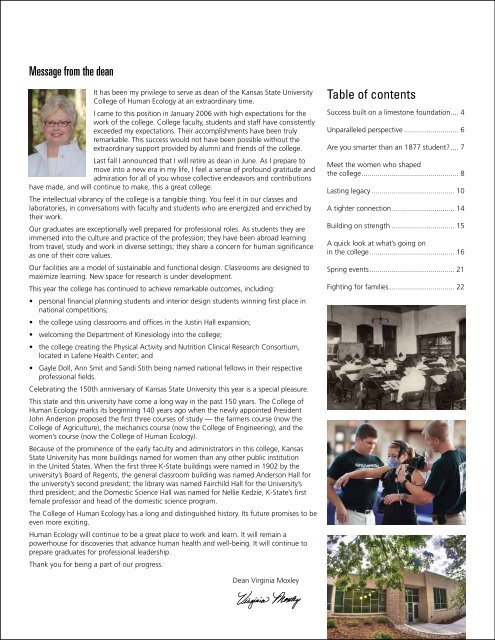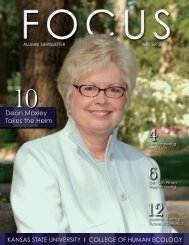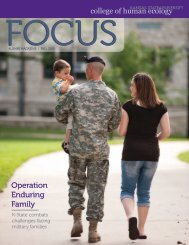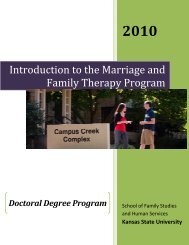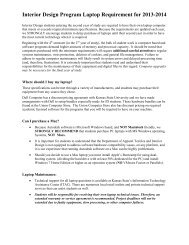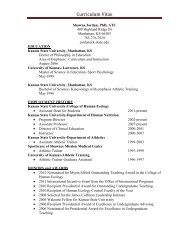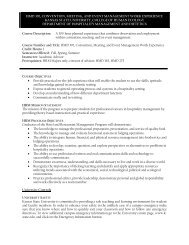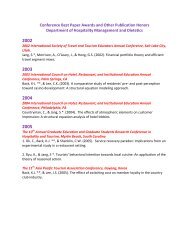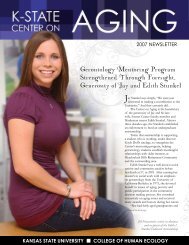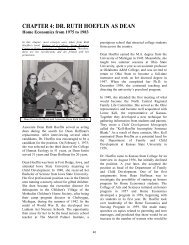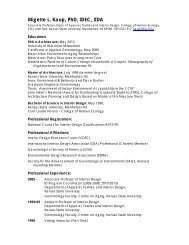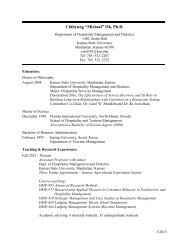Spring 2013 - College of Human Ecology - Kansas State University
Spring 2013 - College of Human Ecology - Kansas State University
Spring 2013 - College of Human Ecology - Kansas State University
Create successful ePaper yourself
Turn your PDF publications into a flip-book with our unique Google optimized e-Paper software.
Message from the dean<br />
It has been my privilege to serve as dean <strong>of</strong> the <strong>Kansas</strong> <strong>State</strong> <strong>University</strong><br />
<strong>College</strong> <strong>of</strong> <strong>Human</strong> <strong>Ecology</strong> at an extraordinary time.<br />
I came to this position in January 2006 with high expectations for the<br />
work <strong>of</strong> the college. <strong>College</strong> faculty, students and staff have consistently<br />
exceeded my expectations. Their accomplishments have been truly<br />
remarkable. This success would not have been possible without the<br />
extraordinary support provided by alumni and friends <strong>of</strong> the college.<br />
Last fall I announced that I will retire as dean in June. As I prepare to<br />
move into a new era in my life, I feel a sense <strong>of</strong> pr<strong>of</strong>ound gratitude and<br />
admiration for all <strong>of</strong> you whose collective endeavors and contributions<br />
have made, and will continue to make, this a great college.<br />
The intellectual vibrancy <strong>of</strong> the college is a tangible thing. You feel it in our classes and<br />
laboratories, in conversations with faculty and students who are energized and enriched by<br />
their work.<br />
Our graduates are exceptionally well prepared for pr<strong>of</strong>essional roles. As students they are<br />
immersed into the culture and practice <strong>of</strong> the pr<strong>of</strong>ession; they have been abroad learning<br />
from travel, study and work in diverse settings; they share a concern for human significance<br />
as one <strong>of</strong> their core values.<br />
Our facilities are a model <strong>of</strong> sustainable and functional design. Classrooms are designed to<br />
maximize learning. New space for research is under development.<br />
This year the college has continued to achieve remarkable outcomes, including:<br />
• personal financial planning students and interior design students winning first place in<br />
national competitions;<br />
• the college using classrooms and <strong>of</strong>fices in the Justin Hall expansion;<br />
• welcoming the Department <strong>of</strong> Kinesiology into the college;<br />
• the college creating the Physical Activity and Nutrition Clinical Research Consortium,<br />
located in Lafene Health Center; and<br />
• Gayle Doll, Ann Smit and Sandi Stith being named national fellows in their respective<br />
pr<strong>of</strong>essional fields.<br />
Celebrating the 150th anniversary <strong>of</strong> <strong>Kansas</strong> <strong>State</strong> <strong>University</strong> this year is a special pleasure.<br />
This state and this university have come a long way in the past 150 years. The <strong>College</strong> <strong>of</strong><br />
<strong>Human</strong> <strong>Ecology</strong> marks its beginning 140 years ago when the newly appointed President<br />
John Anderson proposed the first three courses <strong>of</strong> study — the farmers course (now the<br />
<strong>College</strong> <strong>of</strong> Agriculture), the mechanics course (now the <strong>College</strong> <strong>of</strong> Engineering), and the<br />
women’s course (now the <strong>College</strong> <strong>of</strong> <strong>Human</strong> <strong>Ecology</strong>).<br />
Because <strong>of</strong> the prominence <strong>of</strong> the early faculty and administrators in this college, <strong>Kansas</strong><br />
<strong>State</strong> <strong>University</strong> has more buildings named for women than any other public institution<br />
in the United <strong>State</strong>s. When the first three K-<strong>State</strong> buildings were named in 1902 by the<br />
university’s Board <strong>of</strong> Regents, the general classroom building was named Anderson Hall for<br />
the university’s second president; the library was named Fairchild Hall for the <strong>University</strong>’s<br />
third president; and the Domestic Science Hall was named for Nellie Kedzie, K-<strong>State</strong>’s first<br />
female pr<strong>of</strong>essor and head <strong>of</strong> the domestic science program.<br />
The <strong>College</strong> <strong>of</strong> <strong>Human</strong> <strong>Ecology</strong> has a long and distinguished history. Its future promises to be<br />
even more exciting.<br />
<strong>Human</strong> <strong>Ecology</strong> will continue to be a great place to work and learn. It will remain a<br />
powerhouse for discoveries that advance human health and well-being. It will continue to<br />
prepare graduates for pr<strong>of</strong>essional leadership.<br />
Thank you for being a part <strong>of</strong> our progress.<br />
Table <strong>of</strong> contents<br />
Success built on a limestone foundation..... 4<br />
Unparalleled perspective............................ 6<br />
Are you smarter than an 1877 student..... 7<br />
Meet the women who shaped<br />
the college................................................. 8<br />
Lasting legacy.......................................... 10<br />
A tighter connection................................ 14<br />
Building on strength................................ 15<br />
A quick look at what’s going on<br />
in the college........................................... 16<br />
<strong>Spring</strong> events........................................... 21<br />
Fighting for families................................. 22<br />
Dean Virginia Moxley


